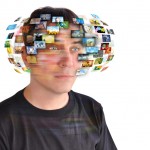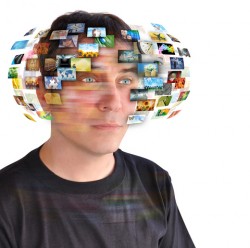We Are Our Images!
We are our Images! (Part I of 2)
This 2-post series is a modified post that I wrote for my graduate students (Cognitive Psychology and the Visual Display of Information) this week to explain the role of imagery, and how that relates to story. This post is broken into two parts – the first is a background on images. The second is how that relates to story. When I speak of imagery in this sense, I am talking about the images we see when we close our eyes – what we think of as products of our imagination, dreaming, or that which lives in our mind’s eye. They are all the same, and play a very important role in our lives… We are our images!
The first thing to know about human beings is that we are beings. Everything single thing that we understand as “being” on this planet is physically-based. Every single thing that we perceive, or take in, is based on the physical. Everything is physical. Everything.

We often like to “think” that we are thinking beings. We have an image of ourselves as logical, rational entities that invent and create the world through our mental prowess. However, thinking that we are thinking beings is a largely a product of the Age of Enlightenment, that cultural/political movement a couple of hundred years ago that championed the intellect over church and state. That movement, which was in many ways an effort to separate from the Church-as-political-entity, created a strong belief system such that we have come to think of it as being a scientific fact. But it’s just a belief system. Here are some sentences that express that belief system:
1) The body is separate from the mind,
2) We are thinking beings,
3) All things belong in a hierarchy, and
4) Our thinking ability puts us at the top of the hierarchy (e.g. separates us from animals and animalistic behaviors)
Side note – It’s always convenient when the one doing the ‘hierarch-ing’ happens to land at the top, isn’t it?
Today, research in the fields of cognitive psychology and neuroscience are showing us that, in fact, we are experiencing beings first, whose understanding of the world is generated from bodily experiences in relationship to our physical environments. We have instincts, and often act in ways that seem unpredictable or illogical to us as thinking beings, and which we may label as ‘animal-like’, but which are perfectly logical for experiencing beings.
So what does it mean to say that it’s all about the body? Here’s how it works:
I see a tree. I don’t think it. I understand the tree by sight, touch (rough bark, smooth), smell (ooh, pine needles), maybe taste, sound (wind rustling the leaves), further touch (it’s cool on my skin when I stand here, made by the tree = shade) further sight (it’s also darker here, made by the tree = shade) and so forth. The senses are the way we literally take in the world – they are the gateway for all of the “out there” to get “in here”, into you. As a person, if I want someone to get a piece of information I have send them an email, a text, or call them. If the environment wants to get someone a piece of information, it comes via a smell, taste, touch, etc.
Now let’s step inside the brain. The “stuff” that is picked up by our senses is called stimuli – electrical impulses that travel up the nervous system to the brain where it becomes an image. The brain works by analogies a lot like texting – the first few bits of information pull the most likely related thing it associates with. Therefore, images are new information (including an emotional response, such as I like the shade on my arm because I feel comforted by it), plus related information – past memories, knowledge, emotions or feelings. Just like texting often gives us the wrong word because it is working on what it already knows, images can sometimes become stuck and direct us toward repetitive, non-serving behaviors. And, just like we have to override the phone with our consciousness to put in the word we intend to text, we have to train our conscious mind to recognize and work with images in order to correct repetitive patterns.
Back to the brain’s point of view. To keep it simple, picking up all of this stimuli means the right brain is a constant kaleidoscope of images/experiences. This is because our experiencing of the world is constant. You don’t just stop smelling … 1,2,3 stop … you pick up scents all the time. Same with touch, for example – we may attend to other things, like this blog I’m writing, but my fingers never stop ‘touching’ the keyboard. Since we are constantly experiencing, we are constantly ‘imaging’. This means that image is holistic and all at once, because experiencing is holistic and all at once.
All of this brings up two big questions: What does the brain do with all this ‘all-at-onceness’? And, how do we take all of that ‘all-at-onceness’ so that we can convey our experiences to someone else? That’s the subject for Part II of this post.
